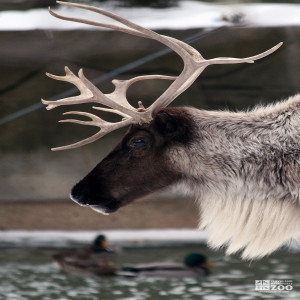Reindeer
[Rangifer tarandus]

The reindeer is the only deer in which the female carries antlers. The antlers are long, sweeping beams with forward-pointing brow tines. Males shed their antlers in November-April, and females in May-June. The feet are very large with deeply cleft hoofs that aid in walking on snow and soft earth. When they walk, a clicking sound it made by a tendon slipping over a bone in the foot. Weight can range up to about 700 lbs. Reindeer live in herds that persist for many years. In North America, naturalists have identified about 30 herds which do not mix with other herds, and which migrate together. The herds range in size from 20 to 200,000. In Europe they have been semi-domesticated for 3,000 years. They are allowed to form herds and move about freely, but some selective breeding is done. One fawn is born when the herd arrives at its summer feeding grounds. For the first several weeks the fawn is hidden and the female comes to nurse it several times per day. In just a few weeks it is able to eat on its own and must be ready to migrate in the fall to the winter feeding grounds.
Location: Tufted Deer Yard (Historical Location)
Share:
Range
The range of the reindeer is considered circumpolar which means around the polar area of the planet.
Habitat
The habitat of the reindeer is the Tundra and Arctic woodlands.
Conservation Status
VulnerablePrimary Threats
Human Wildlife CoexistenceGestation
Gestation in reindeer is 210 to 240 days.
Litter
Reindeer have 1 calf in a litter.
Behavior
Reindeer live in herds that persist for many years. In North America, naturalists have identified about 30 herds which do not mix with other herds, and which migrate together. The herds range in size from 20 to 200,000. In Europe they have been semi-domesticated for 3,000 years. They are allowed to form herds and move about freely, but some selective breeding is done. Their skin is used for clothing, their flesh for meat, and their antlers for tools.
Reproduction
One reindeer fawn is born when the herd arrives at its summer feeding grounds. For the first several weeks the fawn is hidden and the female comes to nurse it several times per day. In just a few weeks it is able to eat on its own and must be ready to migrate in the fall to the winter feeding grounds.
Wild Diet
Grass, sedges, lichen, birch and willow leaves
Zoo Diet
Hay and grain


